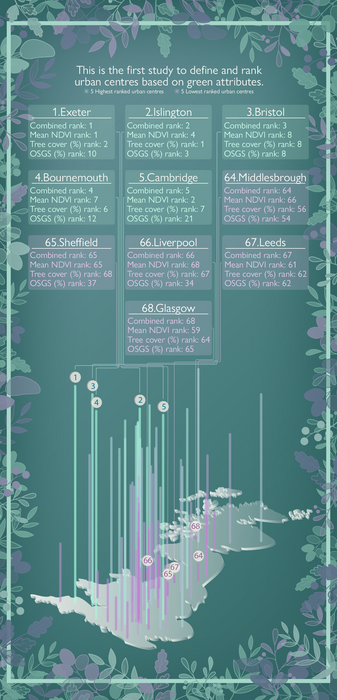A new study has discovered that Great Britain’s city centers differ significantly in their green attributes—like vegetation, tree cover, and parks—with possible impacts on social equity, biodiversity, and human health.

Researchers used a new greenness metric to rank the UK’s 68 urban centers with a population of over 100,000, with the top five being Exeter, Islington, Bristol, Bournemouth, and Cambridge, and the bottom five being Glasgow, Middlesbrough, Sheffield, Liverpool, and Leeds. Image Credit: Anne-Lise Paris (www.in-graphidi.com), PLOS, CC-BY 4.0 (https://creativecommons.org/licenses/by/4.0/).
Dr. Jake Robinson of Flinders University and collaborators at the University of Sheffield, UK, present such outcomes in the open-access journal PLOS ONE on November 23rd, 2022.
In urban ecosystems, vegetation cover, trees, and public greenspaces, such as parks and sports fields, add to biodiversity and human health. While several studies performed earlier have quantified such so-called “greenness” in wider suburban areas, none have made it a point to particularly concentrate on city centers.
Here people of different backgrounds spend a lot of time on activities like recreation, work, and shopping.
Since several people’s lives might be impacted by the greenness of city centers, Robinson and collaborators examined green metrics of urban centers for almost 68 municipalities in Great Britain having populations of a minimum of 100,000.
Their examination integrated three metrics of greenness: the presence of greenspaces, tree cover, and the normalized difference vegetation index (NDVI). This utilizes satellite observations of absorption and light reflection to quantify vegetation cover in a provided area.
Integrating all three metrics into a single greenness score, the scientists discovered that the urban center of Exeter ranks the highest, followed by Islington, Bournemouth, Bristol, and Cambridge. Glasgow’s urban center is the least green, with Middlesbrough, Sheffield, Liverpool, and Leeds also in the lower five.
The authors observe that the top five urban centers are all situated in the south of England, while the bottom five urban centers connect to ex-industrial regions in the north of Great Britain.
The additional analysis exposed a statistical link between a lower greenness score and greater levels of deprivation, as quantified per crime risk, economics, health, education, and other linked metrics. Besides, areas with bigger populations consisted of lower tree coverage and lower NDVI scores but did not consist of fewer green spaces.
Such findings underline disparities in the greenness of city centers throughout Great Britain. Additional research could integrate alternative metrics of greenness or employ a similar analysis to city centers outside of Great Britain.
This work could help inform efforts by local authorities and urban planners to boost the greenness of city centers in an equitable manner.
Dr. Jake Robinson, Flinders University
Journal Reference:
Robinson, J. M., et al. (2022) Urban center green metrics in Great Britain: A geospatial and socioecological study. PLOS One. doi.org/10.1371/journal.pone.0276962